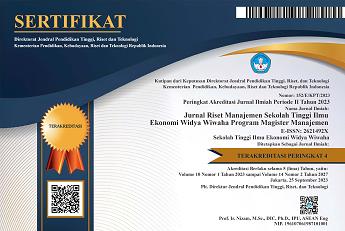ANALISIS PERBANDINGAN PENGUNGKAPAN TATA KELOLA PERUSAHAAN PADA BANK UMUM KONVENSIONAL DAN BANK UMUM SYARIAH DI INDONESIA 2010-2013
DOI:
https://doi.org/10.32477/jrm.v2i2.84Keywords:
content analysis, Conventional Commercial Bank (BUK), Islamic Commercial Bank (BUS), corporate governance, disclosureAbstract
This study aims to analyze the disclosure level ofcorporate governance report in the annual report of Conventional Commercial Bank (BUK) and Islamic Commercial Bank (BUS) in Indonesia in 2010-2013 with the indicators mentioned in the Bank Indonesia Regulation Number 8I4 I PBI I 2006 which was later revised by Bank Indonesia Regulation No. 8I14 I PBI I 2006 for the BUK and Bank Indonesia Regulation No. 11I33 I PBI I 2009 for BUS. In addition, this study analyzes and compares the growth rate of the disclosure. To achieve the objectives of the research, this study uses content analysis method. The results show that of the eight BUSs studied, only three banks (38%) provide corporate governance disclosure with more than 75%. While for the BUKs sampled, all provide corporate governance disclosure with more than 75%. Related to the growth of the disclosure, the average growth of disclosure for four years,for BUS is 6.27% and for BUK is 3.41%. The highest difference between the disclosure level of BUS and BUK is about 50%.
References
Abu-Tapanjeh, Abdussalam Mahmoud (2009). Corporate Governance from the Islamic Perspective: A Comparative Analysis with OECD Principles”, Critical Perspectives on Accounting, 20, 556–567.
Adiono, Luthfi Cahyo dan Mahfud Sholihin (2014). “Analisis Pengungkapan Tata Kelola Bank Syariah Di Indonesia”, Jurnal Keuangan dan Perbankan,18 (2), 268-227.
Chatterjee, D. (2011). “A Content Analysis Study on Corporate Governance Reporting by Indian Companies”, Corporate Reputation Review, 14 (3), 234-246.
Darmadi, Salim (2013). “ Corporate Governance Disclosure in the Annual Report: An Explanatory Study on Indonesian Islamic Banks”, Humanomics, 29 (1), 4-23.
Krippendorff, Klaus (1980). Content Analysis: An Introduction to Its Methodology. Beverly Hills: Sage.
Mehran, Hamid, Morrison, Alan, dan Joel Shapiro (2011). “Corporate Governance and Banks: What Have Learned from the Financial Crisis?”, Federal Reserve Banks of New York Staff Reports, no. 502.
Organization for Co-Oporation and Development. (2004). OECD Principles of Corporate Governance. Paris: OECD.
Peraturan Bank Indonesia No. 8/4/PBI/2006 Tentang Pelaksanaan Good Corporate Governance Bagi Bank Umum.
Peraturan Bank Indonesia No. 8/14/PBI/2006 Tentang Peruabahan Atas Peraturan Bank Indonesia No 8/4/PBI/2006 Tentang Pelaksanaan Good Corporate Governance Bagi Bank Umum.
Peraturan Bank Indonesia No. 11/33/PBI/2009 Tentang Pelaksanaan Good Corporate Governance bagi Bank Umum Syariah dan Unit Usaha Syariah.
(Footnotes)
Kementrian Koordinator Bidang Ekonomi, Keuangan, dan Industri telah membentuk
Komite Nasional Kebijakan Governance (KNKG) agar secara khusus menangani tata kelola di Indonesia, sementara MTI menginisiasi berdirinya The Indonesian Institute for Corporate Governance.









